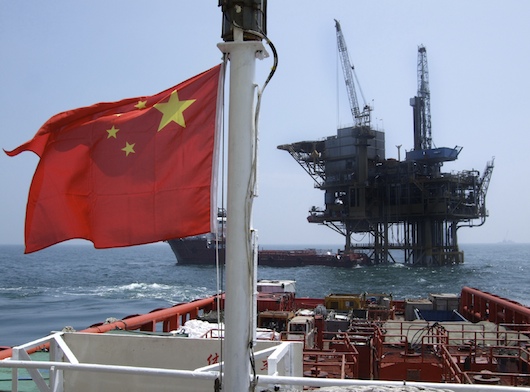According to sources, the resolution on oil imports means extra supplies to China, up to 600,000 barrels of crude per day. This initiative will allow the second-largest oil consumer to buy more crude in the market.
China's largest independent refiner Shandong Dongming Petrochemical this week has already received permission to import 150 thousand barrels of oil a day. Panjin Beifang Company gained the right to receive 140 thousand barrels of oil per day.
According to the US Energy Information Administration (EIA), oil demand in China this year will be about 11 million barrels per day (about 550 million tons per year), and will increase to 11.34 million barrels per day in 2016.
China itself produces 4.61 million barrels per day, or about 230.5 million tons per year (EIA estimate for 2015). And production in China is growing much slower than the demand: in 2008, production was 3.99 million barrels per day (about 199.5 million tons a year).
Thus, over the last seven years, the level of oil production in China rose by 15.5%, while demand increased by more than 38% despite the economic slowdown in China - mainly due to the change of the Chinese economic model.
Earlier, China's economy was tied to cheap labor, the price of which allowed to produce cheap goods exported all over the world, but the standard of living in China has seriously increased in recent years. This means not only an increase in the cost of the same labor force, but also the growth of the population's needs. China swapped from bicycles to cars. These and other changes in the economy leads to an increase in oil consumption, and hence the oil.
The growth of domestic production in China continues, according to the National Commission for Development and Reform Commission of China, in the first four months of this year, oil production increased by 1.6% compared to the same period of 2014 and amounted to 69.58 million tons. On Wednesday, the Chinese state company CNPC announced the opening of today's biggest oil reserve in China. The field's reserves, discovered in Shanxi Province (center of China), could reach 100 million tons, which would annually produce up to 700 thousand tons. Yet, still, import is the basis for Chinese oil well-being.
As told Thomson Reuters Kortes, China has been increasing its foreign purchases since July last year (when the oil prices started falling). In July, it was 23.75 million tons, but reached 30.37 million by December. Then there was a slight decline (in January, February and March, China imported 27.9 million, 25.5 million and 26.8 million tons respectively).
In April, imports again rose to 30.28 million tons. In May, China oil imports surpassed even the United States with 7.37 million barrels per day compared to 6.54 million.
According to the forecast of consulting company ICIS, oil imports to China will be growing, and by 2020 will amount to 434 million tons per year, or 8.68 million barrels per day.
source: reuters.com
China's largest independent refiner Shandong Dongming Petrochemical this week has already received permission to import 150 thousand barrels of oil a day. Panjin Beifang Company gained the right to receive 140 thousand barrels of oil per day.
According to the US Energy Information Administration (EIA), oil demand in China this year will be about 11 million barrels per day (about 550 million tons per year), and will increase to 11.34 million barrels per day in 2016.
China itself produces 4.61 million barrels per day, or about 230.5 million tons per year (EIA estimate for 2015). And production in China is growing much slower than the demand: in 2008, production was 3.99 million barrels per day (about 199.5 million tons a year).
Thus, over the last seven years, the level of oil production in China rose by 15.5%, while demand increased by more than 38% despite the economic slowdown in China - mainly due to the change of the Chinese economic model.
Earlier, China's economy was tied to cheap labor, the price of which allowed to produce cheap goods exported all over the world, but the standard of living in China has seriously increased in recent years. This means not only an increase in the cost of the same labor force, but also the growth of the population's needs. China swapped from bicycles to cars. These and other changes in the economy leads to an increase in oil consumption, and hence the oil.
The growth of domestic production in China continues, according to the National Commission for Development and Reform Commission of China, in the first four months of this year, oil production increased by 1.6% compared to the same period of 2014 and amounted to 69.58 million tons. On Wednesday, the Chinese state company CNPC announced the opening of today's biggest oil reserve in China. The field's reserves, discovered in Shanxi Province (center of China), could reach 100 million tons, which would annually produce up to 700 thousand tons. Yet, still, import is the basis for Chinese oil well-being.
As told Thomson Reuters Kortes, China has been increasing its foreign purchases since July last year (when the oil prices started falling). In July, it was 23.75 million tons, but reached 30.37 million by December. Then there was a slight decline (in January, February and March, China imported 27.9 million, 25.5 million and 26.8 million tons respectively).
In April, imports again rose to 30.28 million tons. In May, China oil imports surpassed even the United States with 7.37 million barrels per day compared to 6.54 million.
According to the forecast of consulting company ICIS, oil imports to China will be growing, and by 2020 will amount to 434 million tons per year, or 8.68 million barrels per day.
source: reuters.com



















